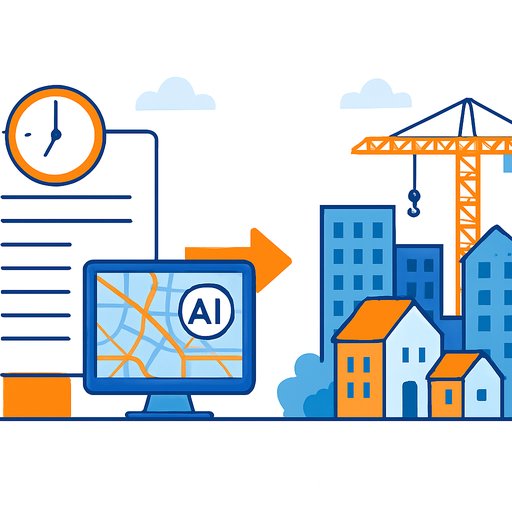SwiftGov: AI + GIS that speeds permitting and boosts urban development
Swiftbuild.ai's SwiftGov modernizes government building and permitting with AI-driven plan review and integrated geospatial data. The result: faster approvals, fewer errors, and clearer accountability across departments and applicants.
For agencies under pressure from housing demand and legacy workflows, SwiftGov removes bottlenecks by automating compliance checks, organizing data in one place, and standardizing reviews across teams and jurisdictions.
How it works: AI plan review + geospatial context
SwiftGov analyzes site and building plans against local codes and standards, flagging issues before they hit the reviewer's desk. It adapts to local forms, rules, and processes, so staff keep their existing review logic while saving hours per submission.
Co-founder Sabrina Dugan holds multiple AI patents, including an AI-driven DWG system for land development code compliance. That expertise shows up in the platform's accuracy and its fit for government-grade requirements.
GIS integration brings zoning, land use, and parcel data into the same workflow. Staff and applicants see the same maps, the same rules, and the same status-reducing back-and-forth and misinterpretation.
Documented results
- Hernando County cut single-family home review times by 93%-from 30 days to 2 days.
- City of Titusville reports some zoning reviews completed in under an hour.
- Automated checks reduce rework and costly mistakes common in manual, paper-heavy reviews.
Analytics for managers
"Swift Analytics" surfaces bottlenecks, measures cycle times, and highlights code sections that trigger the most corrections. Leaders get actionable insights to refine policies, staffing, and service levels-without spinning up a separate data project.
Security, privacy, and procurement fit
SwiftGov emphasizes secure, in-country hosting and "Narrow AI" that assists human reviewers instead of making final decisions. That approach supports data sovereignty expectations and risk controls common in government contracts.
Access controls, audit trails, and transparent rules improve oversight. The platform centralizes information while keeping sensitive data locked to agency standards.
Who benefits
- Agencies: faster approvals, lower administrative burden, higher compliance accuracy.
- Builders and developers: shorter timelines, clearer requirements, fewer resubmittals.
- Residents: quicker housing delivery and more predictable public services.
- Staff: less repetitive work, more time for complex reviews and policy improvements.
Why this matters for GovTech strategy
Specialized AI that embeds local code knowledge creates a high barrier for generic tools. SwiftGov illustrates how deep domain integration beats one-size-fits-all platforms in regulated workflows.
For CIOs and permitting directors, it's a practical model: keep infrastructure standards, bring in domain-specific AI where it removes measurable friction, and require clear auditability.
Risks and how to handle them
- Data privacy and security: require in-country hosting, encryption at rest/in transit, role-based access, and third-party audits.
- Algorithmic bias: run periodic sampling of AI flags, compare outcomes across neighborhoods and applicant types, and document corrective actions.
- Workforce impact: retrain staff for exception handling, field inspections, policy improvements, and data stewardship.
- Implementation cost and change resistance: start with a pilot (single permit type), show cycle-time gains, then scale with a clear RACI and success metrics.
- Data quality: establish data ownership, standardize forms and code references, and clean legacy records before full rollout.
Implementation playbook for your agency
- Prioritize high-volume permit types with frequent resubmittals and long queues.
- Map current review steps, forms, and code citations; remove duplicate checks.
- Run a 90-day pilot with clear KPIs: cycle time, resubmittal rate, first-pass yield, and staff hours saved.
- Integrate GIS layers for zoning, floodplain, setbacks, and overlays used in your reviews.
- Adopt "human-in-the-loop" approvals with audit logs and standardized comment libraries.
- Publish a public status tracker for transparency and fewer inbound inquiries.
- Train reviewers and permit techs; appoint a data steward for ongoing quality.
- Codify governance: model versioning, exception handling, and periodic bias testing.
Urban planning and "smart city" impact
With AI + GIS, planners can test scenarios, forecast growth patterns, and ensure projects fit code and environmental constraints before approval. This reduces redesigns and supports resilient land use decisions.
The federal government's AI use-case momentum signals agency-wide readiness. See the public AI use-case inventory here: AI.gov Use Case Inventory.
Roadmap signals to watch
- Deeper code awareness across jurisdictions and permit classes.
- More "Swift Analytics" features for forecasting workload and policy impact.
- Predictive governance: anticipating bottlenecks and modeling policy changes before rollout.
- Broader integrations across inspections, licensing, and enforcement in a single hub.
What this means for your office
- Cycle-time reductions like 30 days to 2 days are achievable with the right scope and governance.
- Standardized, explainable checks beat ad hoc reviews for fairness and predictability.
- Transparent status and shared GIS context cut calls, emails, and confusion.
- Start small, measure relentlessly, and scale what works.
If you're planning workforce upskilling for AI-enabled permitting and inspections, you can browse curated learning by job role here: Complete AI Training: Courses by Job.
Your membership also unlocks:






